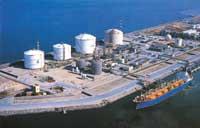Liquefied natural gas regasification facilities
The natural gas in the moat is sometimes liquefied and transported on methane vessels to import terminals. However, its use as fuel requires the regasification of liquefied gas.
Methane vessels transporting LNG are plumbed into the storage tanks of regasification facilities. In ships, liquefied natural gas is at very low temperature (-160°C) and occupies 630 times less than the original volume, situation in which it is driven to storage tanks. The location of the regasification facilities, in general, in industrial areas or close to inhabited areas, makes it essential to adopt great security measures in the construction of the tanks. Among other things, measures must be taken to prevent stratification by the density difference of liquefied gases.

Storage tanks are usually cylindrical or spherical and usually have an internal and external structure. These structures can be made of metal material or pressed concrete. The most widely used storage systems are aerial. However, in order to achieve high safety, earthquake protection and minimal environmental impact, buried tanks are used in some modern terminals. This prevents, among other things, the risk of gas emission abroad.
Various processes occur in regasification plants. First, the liquefied natural gas in the storage tank is extracted from it by pumps. Subsequently, through the collector, the gas is driven to the evaporator zone. In the evaporators, the liquefied gas is gasified at 75 bar of pressure, obtaining a steam at 0 °C. The most common evaporation systems are evaporators using seawater. Finally, the natural gas obtained in the evaporators, once passed by the corresponding measurement installation, is driven to the gas pipeline network at different pressures (72 bar, 45 bar, etc. ). ).
Buletina
Bidali zure helbide elektronikoa eta jaso asteroko buletina zure sarrera-ontzian











